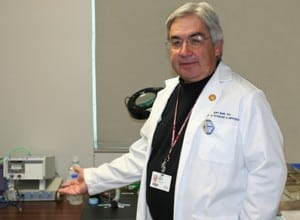UAMS-Harvard Arthritis Study Among Top 5 for 2010
Jan. 5, 2011 | A study with the potential to bring new treatments for rheumatoid arthritis has brought a second round of accolades for Jerry Ware, Ph.D., of the University of Arkansas for Medical Sciences (UAMS). Ware and Harvard Medical School’s David Lee, Ph.D., the lead author, were recognized in May by the Arthritis Foundation for producing the top advance in arthritis research. Now their study has been named by the Faculty of 1000 as one of the five most important papers in biology of 2010. The Faculty of 1000 is a website for scientists providing rankings and commentary on scientific research papers. The service acts as a filter, highlighting the most significant research along with evaluations of research by other scientists. “The recognition is nice,” Ware said, “but the real issue is moving forward and using this information for new therapies to help patients living with rheumatoid arthritis.” UAMS College of Medicine Dean Debra H. Fiser, M.D., said the medical breakthrough deserves the recognition. “Finding effective treatments for arthritis is the ultimate goal for researchers across the globe,” Fiser said. “This discovery affirms the power of collaboration and the significant contributions to science made right here at UAMS.” Ware, professor of physiology and biophysics, collaborated with Lee on the study and article, “Platelets Amplify Inflammation in Arthritis Via Collagen-Dependent Microparticle Production.” It was published in the January 2010 issue of Science. Ware said the study began a few years ago with a phone call from Lee, who was experimenting with synovial fluid from patients with RA. Lee e-mailed photos to Ware, who noticed the strong platelet signaling as a result of Lee’s staining with a platelet-specific protein. But Ware also recognized that the “platelets” they were seeing might actually be platelet fragments called microparticles that had found their way into the joints. As Lee’s study progressed, Ware, by happenstance, was able to provide mice that were exactly of the type needed for advancing their work. The mice were bred so that each was missing a collagen receptor on the surface of their platelets. And that collagen receptor turned out to be the receptor that was worsening the inflammatory disease in patients with rheumatoid arthritis. Their work may have implications for other autoimmune diseases too. “The next challenge is to move forward and develop therapies based on this information,” Ware said. “It’s possible, but it will take considerable effort.” The research was taken to UAMS BioVentures, and a UAMS and Harvard patent is pending. BioVentures was created in 1997 to help UAMS researchers patent their discoveries, license intellectual property and assist with start-up companies. Ware is excited about the potential benefits for RA patients, and he’s also happy because it shows platelet research has matured beyond clotting. “Platelet scientists are no longer just coagulation experts,” Ware said. “We’re also starting to learn about cancer, immunology and inflammation, so that excites me, too, knowing we may contribute to new therapies for a wide range of diseases.” |
